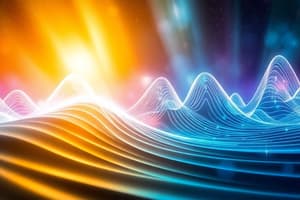Podcast
Questions and Answers
What type of wave is a sound wave?
What type of wave is a sound wave?
- Longitudinal Wave (correct)
- Transverse Wave
- Surface Wave
- Standing Wave
The amplitude of a sound wave determines its frequency.
The amplitude of a sound wave determines its frequency.
False (B)
What is represented by the Greek letter lambda (λ) in sound waves?
What is represented by the Greek letter lambda (λ) in sound waves?
Wavelength
In sound waves, areas of higher density are called ______ and areas of lower density are called ______.
In sound waves, areas of higher density are called ______ and areas of lower density are called ______.
Match the following characteristics of sound waves with their descriptions:
Match the following characteristics of sound waves with their descriptions:
Higher frequency sound waves correspond to which of the following?
Higher frequency sound waves correspond to which of the following?
Transverse waves are characterized by particle oscillation perpendicular to the direction of wave propagation.
Transverse waves are characterized by particle oscillation perpendicular to the direction of wave propagation.
What is the main difference between the frequencies of male and female voices?
What is the main difference between the frequencies of male and female voices?
Flashcards are hidden until you start studying
Study Notes
Sound Waves
- Sound is a form of energy that travels through a medium, creating the sensation of hearing.
- Sound waves are longitudinal, meaning particles in the medium oscillate parallel to the wave's direction.
- Sound waves consist of compressions (high density) and rarefactions (low density) in the medium.
Observing Sound Waves
- Sound waves can be represented graphically to show changes in density and pressure.
- Figure 12.1 A depicts changes in density.
- Figure 12.1 B shows changes in pressure.
- Figure 12.1 C combines changes in density and pressure on a graph.
Characteristics of Sound Waves
- Wavelength (λ): The distance between two consecutive compressions or rarefactions.
- Frequency (ν): The number of compressions or rarefactions passing a point per second. Higher frequency corresponds to higher pitch, while lower frequency corresponds to lower pitch.
- Amplitude (A): The maximum displacement of particles from their rest position. Higher amplitude leads to a louder sound.
- Time Period (T): The time taken for one complete oscillation of pressure or density at a point.
Research Questions
- The relationships between the frequencies of musical notes (sa, re, ga, ma, pa, dha, ni) is a topic of investigation.
- The main difference between the frequencies of male and female voices is a research question.
Diagram Description
- The diagram illustrates a loudspeaker emitting sound waves.
- The waves are represented as compressions (dense areas) and rarefactions (less dense areas).
- The graph shows changes in pressure/density over time, labeled with compression (C), rarefaction (R), and average density/pressure.
Studying That Suits You
Use AI to generate personalized quizzes and flashcards to suit your learning preferences.




